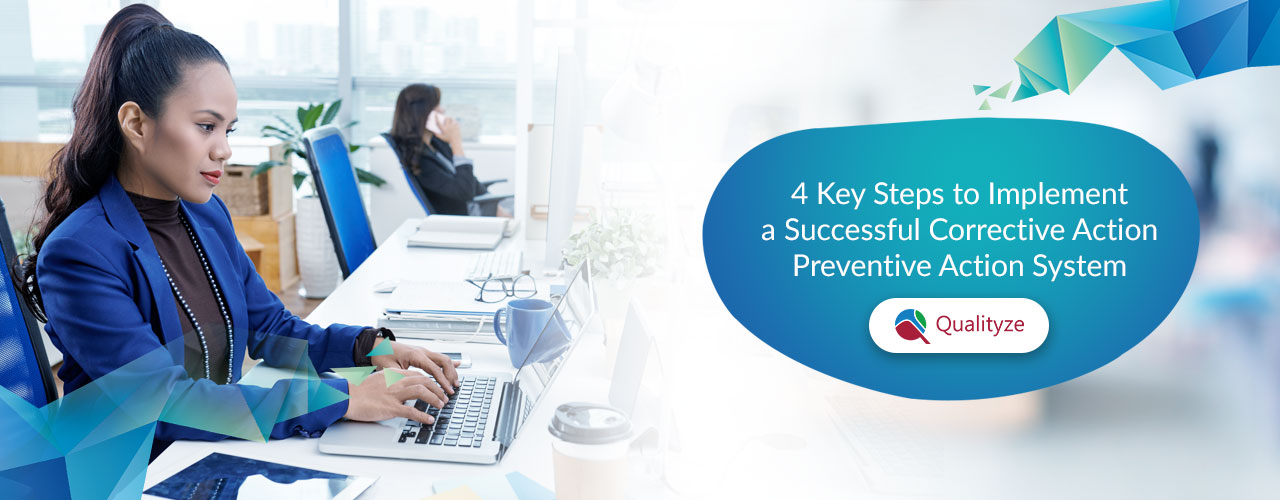Calculate your potential savings with our ROI Calculator
ROI CalculatorCalculate your potential savings with our ROI Calculator
ROI Calculator
Having a well-structured and organized corrective action and preventive action system is vital for any organization to support its improvement activities while meeting compliance and quality requirements. But, it’s no less than a challenge to establish a compliant CAPA system and process especially for highly regulated industries including Lifesciences.
A CAPA management system strengthens your quality management strategy to ensure that none of the quality issues get repeated.
A Corrective Action Preventive Action system refers to the process of investigating and resolving the root cause of the identified nonconformances. The main objective of the CAPA is to prevent the recurrence of a similar problem in the near future. It is applicable for every industry including lifesciences, manufacturing, healthcare, nutraceuticals, etc.
CAPA is a combination of two different terms i.e. Corrective Action and Preventive Action. The basic difference between these terms is Corrective Action is applicable for the problems already occurred whereas Preventive Actions applies to the potential causes of the problem.
An effective CAPA system not only helps to limit the problem occurrences recurrently, but it also helps you to study the trends of such occurrences to make informed decisions. This is the reason, CAPA is referred to as a significant component for a successful quality system that can effectively address the nonconformances.
Plan and Implement a Successful CAPA System to revolve around Deming cycle i.e. Plan, Do, Check, Act.
The effective process starts with the planning. If you want to implement a successful CAPA System, you must plan the resources and various other requirements you might need in the process. Preparing a plan beforehand helps you understand exactly how you should proceed.
All the requirements should be rigorously assessed so to avoid repetition of steps or performing an unnecessary step. Executing the planning step right ensures that you have a direction to follow in order to achieve your business goals.
Planning should include duties that need to be assigned to different team members for successful CAPA implementation until its completion. For example – identifying the valid nonconformances, defining the action plan, implementing it, verifying the effectiveness, and many other tasks that are generally performed under a CAPA system to manage the quality issues with accuracy and efficiency without any impact on the ongoing processes.
This is commonly referred to as the development and implementation step wherein all the planned activities get conducted. The primary process in this step is to formally document the policies, procedures, work instructions, SOPs, etc. that are mutually decided and assigned. The documentation is critical to establish a compliant process and system.
The next process of this step is to start implementing the things as documented. It might require you to provide training to your employees. It will make them even more competent for the job and responsibilities assigned. The training can be provided through online programs, on-job practice sessions, or team meetings as suitable.
For example – if you are going to have an electronic audit management solution, you will need to provide training to your employees – how it works and can be integrated with the existing resources.
Post training, the actual implementation should take place so that your employees can use the new skills and knowledge they gained in the training and demo sessions. Implementation brings the new system in function so that your team can manage the day-to-day CAPA operations effectively and flawlessly, unlike the time-consuming manual processes. So, are you ready to streamline your CAPA system with a smart mechanism?
In this step, you can evaluate and assess the effectiveness of the corrective action and preventive action system you have implemented in your organization. It helps you identify the improvements as well as impact soon after the implementation so that you can realize what’s working for your organization? And what’s not?
The effectiveness check step also enables you to check whether all the compliance and industry standards are duly followed. Most importantly, you need to ask why at every step. It will help you understand the newer improvements so as to drive the culture of continuous improvement in the organization.
You must remember to keep the process iterative so that you don’t miss any improvement, which can help your organization attain business operational excellence within minimum costs of quality.
Therefore, the effective review (check) process is mandatory for introducing more improvements to the process that will help to maintain continuity and sustainability.
No real-world plan can be flawless as they say, “To err is human”. This step is a guide to help you manage the glitches, loopholes, or technical issues that you identified in the effectiveness review step by implementing the right action plan.
Since the objective is to ensure continuous improvement, you must design your CAPA Software system around Deming cycle of Plan, Do, Act, Check.
Setting up such a process manually will be daunting and time-consuming. The best solution here is Qualityze CAPA Management Solution that enables you to perform all the four steps while meeting the compliance and regulatory standards.
With Qualityze, all your CAPA activities including verification and validation of the quality issues identified, investigation of the root cause, implementation of right corrective and preventive action, and documentation of the problems, potential risks, and relevant solutions is as easy as few clicks.
Through its intuitive and configurable interface, Qualityze CAPA management software helps streamline, standardize, and automate the implementation of CAPA process across your organization, while analytics and reporting tools contribute to continuous improvements by offering detailed data, trends, and insights.
To Implement a successful CAPA System is essential for any organization that relies on an objective of continuous improvement. Make sure you establish an effective one with Qualityze CAPA Management Solution to prevent the recurrence of the quality issues once identified and resolved.
If you’re seriously interested to make your quality management and CAPA management processes compliant, you must think of getting Qualityze today!